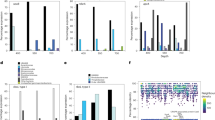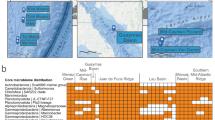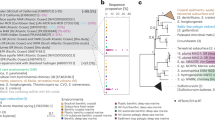Abstract
Bacteria and archaea in the dark ocean (>200 m) comprise 0.3–1.3 billion tons of actively cycled marine carbon. Many of these microorganisms have the genetic potential to fix inorganic carbon (autotrophs) or assimilate single-carbon compounds (methylotrophs). We identified the functions of autotrophic and methylotrophic microorganisms in a vent plume at Axial Seamount, where hydrothermal activity provides a biogeochemical hot spot for carbon fixation in the dark ocean. Free-living members of the SUP05/Arctic96BD-19 clade of marine gamma-proteobacterial sulfur oxidizers (GSOs) are distributed throughout the northeastern Pacific Ocean and dominated hydrothermal plume waters at Axial Seamount. Marine GSOs expressed proteins for sulfur oxidation (adenosine phosphosulfate reductase, sox (sulfur oxidizing system), dissimilatory sulfite reductase and ATP sulfurylase), carbon fixation (ribulose-1,5-bisphosphate carboxylase oxygenase (RuBisCO)), aerobic respiration (cytochrome c oxidase) and nitrogen regulation (PII). Methylotrophs and iron oxidizers were also active in plume waters and expressed key proteins for methane oxidation and inorganic carbon fixation (particulate methane monooxygenase/methanol dehydrogenase and RuBisCO, respectively). Proteomic data suggest that free-living sulfur oxidizers and methylotrophs are among the dominant primary producers in vent plume waters in the northeastern Pacific Ocean.
Similar content being viewed by others
Log in or create a free account to read this content
Gain free access to this article, as well as selected content from this journal and more on nature.com
or
References
Anantharaman K, Breier JA, Sheik CS, Dick GJ . (2013). Evidence for hydrogen oxidation and metabolic plasticity in widespread deep-sea sulfur-oxidizing bacteria. Proc Natl Acad Sci USA 110: 330–335.
Anderson RE, Beltrán MT, Hallam SJ, Baross JA . (2013). Microbial community structure across fluid gradients in the Juan de Fuca Ridge hydrothermal system. FEMS Microbiol Ecol 83: 324–339.
Baker ET, Massoth GJ, Walker SL, Embley RW . (1993). A method for quantitatively estimating diffuse and discrete hydrothermal discharge. Earth Planet Sci Lett 118: 235–249.
Bano N, Hollibaugh JT . (2002). Phylogenetic composition of bacterioplankton assemblages from the Arctic Ocean. Appl Environ Microbiol 68: 505–518.
Caress DW, Clague DA, Paduan JB, Martin JF, Dreyer BM, Chadwick WW et al (2012). Repeat bathymetric surveys at 1-metre resolution of lava flows erupted at Axial Seamount in April 2011. Nat Geosci 5: 483–488.
Cavanaugh CM, Levering PR, Maki JS, Mitchell R, Lidstrom ME . (1987). Symbiosis of methylotrophic bacteria and deep-sea mussels. Nature 325: 346–348.
Chadwick WW, Nooner SL, Butterfield DA, Lilley MD . (2012). Seafloor deformation and forecasts of the April 2011 eruption at Axial Seamount. Nat Geosci 5: 474–477.
Childress JJ, Fisher CR, Favuzzi JA, Sanders NK . (1991). Sulfide and carbon dioxide uptake by the hydrothermal vent clam, Calyptogena magnifica, and its chemoautotrophic symbionts. Physiol Zool 64: 1444–1470.
Dick GJ, Tebo BM . (2010). Microbial diversity and biogeochemistry of the Guaymas Basin deep-sea hydrothermal plume. Environ Microbiol 12: 1334–1347.
Dickson AG, Sabine CL, Christian JR (eds). (2007) Guide to Best Practices for Ocean CO2 Measurements, 191 pp.
Distel DL, Lane DJ, Olsen GJ, Giovannoni SJ, Pace B, Pace NR et al (1988). Sulfur-oxidizing bacterial endosymbionts: analysis of phylogeny and specificity by 16S rRNA sequences. J Bacteriol 170: 2506–2510.
Dziak RP, Haxel JH, Bohnenstiehl DR, Chadwick WW, Nooner SL, Fowler MJ et al (2012). Seismic precursors and magma ascent before the April 2011 eruption at Axial Seamount. Nat Geosci 5: 478–482.
Eng JK, McCormack AL, Yates JR . (1994). An approach to correlate tandem mass spectral data of peptides with amino acid sequences in a protein database. J Am Soc Mass Spectrom 5: 976–989.
Eng JK, Fischer B, Grossmann J, MacCoss MJ . (2008). A fast SEQUEST cross correlation algorithm. J Proteome Res 7: 4598–4602.
Friedrich CG, Rother D, Bardischewsky F, Quentmeier A, Fischer J . (2001). Oxidation of reduced inorganic sulfur compounds by bacteria: emergence of a common mechanism? Appl Environ Microbiol 67: 2873–2882.
Friedrich CG, Bardischewsky F, Rother D, Quentmeier A, Fischer J . (2005). Prokaryotic sulfur oxidation. Curr Opin Microbiol 8: 253–259.
Fuchs BM, Woebken D, Zubkov MV, Burkill P, Amann R . (2005). Molecular identification of picoplankton populations in contrasting waters of the Arabian Sea. Aquat Microb Ecol 39: 145–157.
Ghosh W, Dam B . (2009). Biochemistry and molecular biology of lithotrophic sulfur oxidation by taxonomically and ecologically diverse bacteria and archaea. FEMS Microbiol Rev 33: 999–1043.
Hansell DA . (2005). Dissolved organic carbon reference material program. EOS 86: 318.
Hensen D, Sperling D, Trüper HG, Brune DC, Dahl C . (2006). Thiosulphate oxidation in the phototrophic sulphur bacterium Allochromatium vinosum. Mol Microbiol 62: 794–810.
Huang X, Madan A . (1999). CAP3: a DNA sequence assembly program. Genome Res 9: 868–877.
Huber JA, Butterfield DA, Baross JA . (2003). Bacterial diversity in a subseafloor habitat following a deep-sea volcanic eruption. FEMS Microbiol Ecol 43: 393–409.
Huber JA, Johnson HP, Butterfield DA, Baross JA . (2006). Microbial life in ridge flank crustal fluids. Environ Microbiol 8: 88–99.
Huber JA, Mark Welch DB, Morrison HG, Huse SM, Neal PR, Butterfield DA et al (2007). Microbial population structures in the deep marine biosphere. Science 318: 97–100.
Iverson V, Morris RM, Frazar CD, Berthiaume CT, Morales RL, Armbrust EV . (2012). Untangling genomes from metagenomes: revealing an uncultured class of marine Euryarchaeota. Science 335: 587–590.
Kato S, Hara K, Kasai H, Teramura T, Sunamura M, Ishibashi J-i et al (2009). Spatial distribution, diversity and composition of bacterial communities in sub-seafloor fluids at a deep-sea hydrothermal field of the Suiyo Seamount. Deep Sea Res Pt I 56: 1844–1855.
Lavik G, Stuhrmann T, Bruchert V, Van der Plas A, Mohrholz V, Lam P et al (2009). Detoxification of sulphidic African shelf waters by blooming chemolithotrophs. Nature 457: 581–584.
Lesniewski RA, Jain S, Anantharaman K, Schloss PD, Dick GJ . (2012). The metatranscriptome of a deep-sea hydrothermal plume is dominated by water column methanotrophs and lithotrophs. ISME J 6: 2257–2268.
Lieberman RL, Rosenzweig AC . (2005). Crystal structure of a membrane-bound metalloenzyme that catalyses the biological oxidation of methane. Nature 434: 177–182.
Lilley MD, de Angelis MA, Gordon LI . (1982). CH4, H2, CO and N2O in submarine hydrothermal vent waters. Nature 300: 48–50.
Lilley MD, Feely RA, Trefry JH . (1995) Seafloor Hydrothermal Systems: Physical, Chemical, Biological, and Geological Interactions vol. 91. AGU: Washington, DC.
Lupton JE, Delaney JR, Johnson HP, Tivey MK . (1985). Entrainment and vertical transport of deep-ocean water by buoyant hydrothermal plumes. Nature 316: 621–623.
Marshall KT, Morris RM . (2013). Isolation of an aerobic sulfur oxidizer from the SUP05/Arctic96BD-19 clade. ISME J 7: 452–455.
McCune B, Grace JB . (2002) Analysis of Ecological Communities. MjM Software Design: Gleneden Beach, OR.
Morris RM, Rappe MS, Connon SA, Vergin KL, Siebold WA, Carlson CA et al (2002). SAR11 clade dominates ocean surface bacterioplankton communities. Nature 420: 806–810.
Morris RM, Nunn BL, Frazar C, Goodlett DR, Ting YS, Rocap G . (2010). Comparative metaproteomics reveals ocean-scale shifts in microbial nutrient utilization and energy transduction. ISME J 4: 673–685.
Morris RM, Frazar CD, Carlson CA . (2012). Basin-scale patterns in the abundance of SAR11 subclades, marine Actinobacteria (OM1), members of the Roseobacter clade and OCS116 in the South Atlantic. Environ Microbiol 14: 1133–1144.
Murray AE, Grzymski JJ . (2007). Diversity and genomics of Antarctic marine micro-organisms. Philos Trans R Soc Lond B Biol Sci 362: 2259–2271.
Opatkiewicz AD, Butterfield DA, Baross JA . (2009). Individual hydrothermal vents at Axial Seamount harbor distinct subseafloor microbial communities. FEMS Microbiol Ecol 70: 413–424.
Panchaud A, Scherl A, Shaffer SA, von Haller PD, Kulasekara HD, Miller SI et al (2009). Precursor ACquisition Independent From Ion Count: how to dive deeper into the proteomics ocean. Anal Chem 81: 6481–6488.
Panchaud A, Jung S, Shaffer SA, Aitchison JD, Goodlett DR . (2011). Faster, quantitative, and accurate precursor acquisition independent from ion count. Anal Chem 83: 2250–2257.
Proskurowski G, Lilley MD, Olson EJ . (2008). Stable isotopic evidence in support of active microbial methane cycling in low-temperature diffuse flow vents at 9°50′N East Pacific Rise. Geochim Cosmochim Acta 72: 2005–2023.
Pruesse E, Quast C, Knittel K, Fuchs BM, Ludwig W, Peplies J et al (2007). SILVA: a comprehensive online resource for quality checked and aligned ribosomal RNA sequence data compatible with ARB. Nucleic Acids Res 35: 7188–7196.
Reinthaler T, van Aken HM, Herndl GJ . (2010). Major contribution of autotrophy to microbial carbon cycling in the deep North Atlantic’s interior. Deep Sea Res Pt II 57: 1572–1580.
Robinson JJ, Cavanaugh CM . (1995). Expression of form I and form II RuBisCo in chemoautotrophic symbioses: implications for the interpretation of stable carbon isotope values. Limnol Oceanogr 40: 1496–1502.
Stothard P . (2000). The Sequence Manipulation Suite: JavaScript programs for analyzing and formatting protein and DNA sequences. Biotechniques 28: 1102–1104.
Sunamura M, Higashi Y, Miyako C, Ishibashi J-i, Maruyama A . (2004). Two bacteria phylotypes are predominant in the Suiyo Seamount hydrothermal plume. Appl Environ Microbiol 70: 1190–1198.
Swan BK, Martinez-Garcia M, Preston CM, Sczyrba A, Woyke T, Lamy D et al (2011). Potential for chemolithoautotrophy among ubiquitous bacteria lineages in the dark ocean. Science 333: 1296–1300.
Sylvan JB, Toner BM, Edwards KJ . (2012). Life and death of deep-sea vents: bacterial diversity and ecosystem succession on inactive hydrothermal sulfides. MBio 3: 1–10.
Trotsenko YA, Doronina NV, Govorukhina NI . (1986). Metabolism of non-motile obligately methylotrophic bacteria. FEMS Microbiol Lett 33: 293–297.
Walsh DA, Zaikova E, Howes CG, Song YC, Wright JJ, Tringe SG et al (2009). Metagenome of a versatile chemolithoautotroph from expanding oceanic dead zones. Science 326: 578–582.
Wang Q, Garrity GM, Tiedje JM, Cole JR . (2007). Naïve Bayesian classifier for rapid assignment of rRNA sequences into the new bacterial taxonomy. Appl Environ Microbiol 73: 5261–5267.
Xie W, Wang F, Guo L, Chen Z, Sievert SM, Meng J et al (2011). Comparative metagenomics of microbial communities inhabiting deep-sea hydrothermal vent chimneys with contrasting chemistries. ISME J 5: 414–426.
Zaikova E, Walsh DA, Stilwell CP, Mohn WW, Tortell PD, Hallam SJ . (2010). Microbial community dynamics in a seasonally anoxic fjord: Saanich Inlet, British Columbia. Environ Microbiol 12: 172–191.
Acknowledgements
We thank chief scientists J Delaney and D Kelley and officers and crew of the R/V Thomas G Thompson. This study was supported by grants from the National Science Foundation OCE-1232840 (RM Morris) and OCE-0825790 (BL Nunn) and National Institutes of Health 5P30ES007033-12 and 1S10RR023044. DAH was supported by OCE-1153930. TEM was supported by a University of Iowa Career Development Award.
Author information
Authors and Affiliations
Corresponding author
Ethics declarations
Competing interests
The authors declare no conflict of interest.
Additional information
Supplementary Information accompanies this paper on The ISME Journal website
Rights and permissions
About this article
Cite this article
Mattes, T., Nunn, B., Marshall, K. et al. Sulfur oxidizers dominate carbon fixation at a biogeochemical hot spot in the dark ocean. ISME J 7, 2349–2360 (2013). https://doi.org/10.1038/ismej.2013.113
Received:
Revised:
Accepted:
Published:
Issue date:
DOI: https://doi.org/10.1038/ismej.2013.113
Keywords
This article is cited by
-
Biodiversity and degradation potential of oil-degrading bacteria isolated from sediments of hydrothermal and non-hydrothermal areas of the Southwest Mid-Indian Ocean Ridge
Environmental Science and Pollution Research (2022)
-
Spartina alterniflora raised soil sulfide content by regulating sulfur cycle-associated bacteria in the Jiuduansha Wetland of China
Plant and Soil (2021)
-
The oxidation of hydrocarbons by diverse heterotrophic and mixotrophic bacteria that inhabit deep-sea hydrothermal ecosystems
The ISME Journal (2020)
-
Metaproteomics reveal that rapid perturbations in organic matter prioritize functional restructuring over taxonomy in western Arctic Ocean microbiomes
The ISME Journal (2020)
-
Total Microbial Activity and Sulfur Cycling Microbe Changes in Response to the Development of Hypoxia in a Shallow Estuary
Ocean Science Journal (2020)



